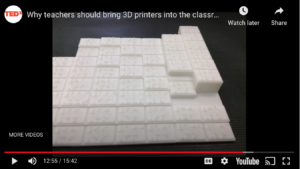Students Making their Own Futures
Teacher Stephen Elford’s TedX talk on the value of 3D printing in classrooms offers a host of reasons for why 3D printing is valuable in classrooms and why more schools and teachers should be introducing them to their learning communities. 3D printers help with:
- Student engagement
- Allowing students to follow their passions
- Providing students with an authentic audience for demonstrating their learning
- Developing communication and leadership skills
- Developing numeracy skills (scale, proportion, etc.)
- Multimodality and multiliteracy
Elford tells us that, particularly in trying to prepare for a future we simply can’t predict, 3D printing offers students the ability to make not just a thing but the ability to make their very own futures through this web of benefits.
Perhaps most important, though, is the implications that 3D printing has for creating equitable learning communities, offering that web of benefits to learners with widely diverse interests and abilities.
Elford provides the example of a vision-impaired student in his class who was missing out on the relationships between elements in chemistry because he, unlike the rest of the class, could not access the periodic table and had to memorize the elements simply from an alphabetic list of them provided in Braille. The list could not demonstrate those relationships that the periodic table renders visible and digestible. Elford and other educators in his community helped this student produce a 3D printed, Braille periodic table:

3D, Braille periodic table produced by Elford’s student
Notice how this model renders 3D the periodic trends and relationships.
He goes on to discuss how 3D printing could further enhance accessibility for vision impaired learners, particularly when it comes to topics such as 3D math and geometry, which are, understandably, more difficult to understand for people who do not have ready visual access to 3D drawings or models.
Looking at the Overlooked
In 2016, the American Library Association and non-profit tech company Benetech teamed up to present/host a session on the ways the 3D printing can be used to make learning more accessible across the diversity of learning. They hosted this session to specifically address the fact that, even for those who have purchased and embraced 3D printers in their learning communities, their potential for creating more accessible learning often goes overlooked. They wanted to highlight that across the range of learning diversity, 3D models can be used effectively to teach about concepts such as DNA, cell structure, the structure of atoms, and other STEM concepts — as well as anything else requiring deep spatial understanding — in a multimodal fashion.
As Forrest Hollingsworth and Naomi Jefferey Petersen point out, “Instructors often use tactile perception to aid students who lack visual perception. However, as this and other models show, tactile concept processing benefits all students.” For instance, geometry was the topic that I had the most trouble with in school because I don’t have the best spatial planning skills, and it was difficult for me to understand 3D concepts that were not rendered in 3D. I remember in elementary school we would often learn mathematic concepts with 3D objects — I remember, in particular, using 1cm cubes in grade 2 to learn about decimals. I would have greatly benefitted from a continuation of the use of 3D objects for learning later mathematical concepts. Using 3D modelling, then, clearly has applications beyond making concepts accessible for vision impaired learners — it provides opportunities across the learning range.
What about the subject range? While using 3D printing has become more accepted in STEM subjects, non-STEM subjects seem, sometimes, to be the overlooked within the overlooked. My teachable subject is social studies — how might I be able to use 3D printing in my future social studies classrooms?
Considering the importance of spatiality in social science and humanities subjects, as well as a wide range of non-spatial things that could benefit from 3D representations, overlooking the socials applications of 3D printing would be a mistake. How much easier would it be to understand topography for physical geographt, for instance, using a 3D model rather than the old school, impossible to read 2D topographical maps?
This issue, thankfully, has not gone unexplored. Many lists of educational applications for 3D printing, such as this one, offer ideas for using 3D models to teach about anthropology, archaeology, architecture, history, and other social disciplines. In the field of museum education, for example, 3D printing can be used to let us do the thing we all always want to do at museums — touch the things on display.
As Neumüller et al. point out in their chapter “3D Printing in Cultural Heritage: Preservation, Accessibility, Research and Education (2014), education is simultaneously embracing multiliteracies and multimodalities and moving more towards a social model of disability, or a model in which “disabilities” (learning, physical, etc.) are seen to be socially created and experienced phenomena rather than medical problems. The concurrent embrace of multi-sensory experiences and a more social, holistic, and inclusive approach to the wide range of abilities of learners combines with the increasing cost efficiency and overall consumer accessibility makes 3D printing an ideal tool to embrace in classrooms as a means by which we can make learning more equitable and accessible for all learners.
References
- Neumüller, M., Reichinger, A., Rist, F., & Kern, C.3D printing for cultural heritage: Preservation, accessibility, research and education. (pp. 119-134). Berlin, Heidelberg: Springer Berlin Heidelberg. doi:10.1007/978-3-662-44630-0_9

Leave a Reply
You must be logged in to post a comment.